
And this is where I nearly lose it.
Filipino food is not a new thing. It’s not this new food trend that sprang, fully formed, from the head of the gods of the New York restaurant scene in 2012. Filipino cooks have been putting in honest work across the country for literally decades. I don’t mean at dinner tables, or as staff meal at someone else’s Asian Fusion restaurant. I mean Filipino immigrant families were serving Filipino immigrant food to their communities long before foodies decided to care at all. On a five block stretch of 1st Avenue, just blocks away from where Maharlika sits today, three Filipino restaurants did business before the financial collapse that shuttered so many restaurants in 2009 – and that’s not to mention all of the restaurants in Queens that never missed a beat.
I grew up with a number of Filipino grocery stores in Cleveland, Ohio that were serving cooked Filipino food to anyone curious enough to walk in – and this was back in the 90s. San Francisco, Los Angeles, Las Vegas, and Chicago have all had their share of Filipino restaurants for decades before any food journalist decided to care about them. Only showcasing these young entrepreneurs – and acting like they are pioneers of a Brave New World – erases the decades of hard work that countless families have been continuously putting in since before Indian food and Thai food became college dorm staples.
I don’t hold a grudge against this new, innovative style of Filipino cooking, and I’m not bemoaning the attention that Maharlika’s group is getting. I think it’s an absolute luxury to have Nicole Ponseca as the de facto spokesperson for the cuisine. She’s brilliant and speaks with eloquence, passion, and painstaking attention to detail when she is interviewed every time any writer anywhere wants to do a story about Filipino food. I have loved Makarlika since it was a pop-up serving Filipino takes on American classics like their delicious Eggs Imelda – Eggs Florentine served with pandesal and laing instead of an English muffin and spinach. I look forward to Kultura every year, and stalk Chicago’s “Filipino Inspired” Oxtail pop-up wherever it goes. It just sticks in my craw how Filipino food had to get cheffy and unaccented for the wider food world to care.
I think Filipino chefs and restaurateurs have shown an incredible amount of patience when asked this question of, “What took you so long?” I often see them contort their way through a maze of answers pointing the finger at the odd confluence of influences, the readiness of the populace to assimilate, and the willingness to adopt to American lifestyles. Really, though the only answer to that question is another question.
“What took you all so long to notice?”





2 Comments
Kenneth browne
October 15, 2016 11:41 pmI just tried sisig last weekend from a mom and pop restaurant by me and there was no pork belly.. but I believe everyone should jump on the Tocinco train!
Sarahlynn Pablo
October 17, 2016 5:21 pmHi Eric, thank you so much for this article, the mention of Kultura Festival and your proper framing of Filipino food. This is why it’s so important that you and other Filipinos across the diaspora tell our own stories. I’ve written a to-be published piece about the history of Filipino food in Chicago, which goes back to the ’20s. And I’m sure you’ve seen the piece in Chicago Magazine. Thanks again, and would love to get together sometime since you’re local. — Sarahlynn, co-founder, Filipino Kitchen #pinoyssupportingpinoys
Leave a Reply